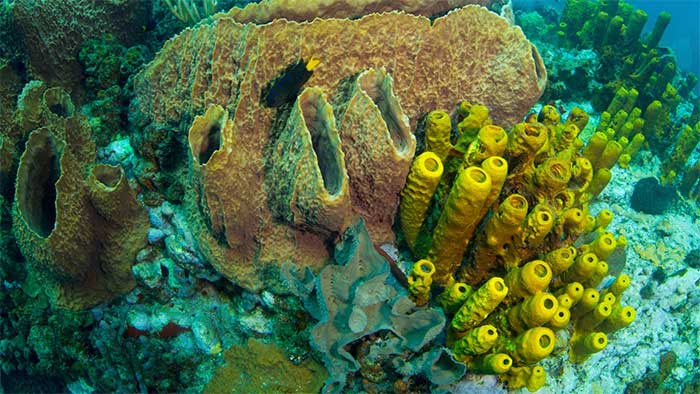Sponges are low-level animals, but they are essential for marine ecosystems. The inability of sponges to withstand rising temperatures poses a serious threat to life on Earth.
Sponges play a crucial role in the ocean by providing shelter and food for many marine creatures, recycling nutrients by filtering seawater daily, and serving as hosts for bacteria that are key to some of the most urgent medical technologies. Now, they are at risk due to the challenges faced by humanity.
Symbiotic Living with Bacteria
Recently, scientists from UNSW (University of New South Wales, Australia) discovered that when tropical sponges are exposed to warmer temperatures, they lose an essential type of bacteria, which may explain why many sponge tissues are dying. The latest research, published on June 14 in ISME Communications, revealed that if sponges are exposed to an increase of 3°C, a crucial type of bacteria will leave the sponge, causing its tissue to become “toxic.
The collaboration between researchers from UNSW, along with Heidi Luter from the Australian Maritime Science Institute and James Bell from Victoria University in Wellington, has added a critical piece to the puzzle regarding the impact of climate change on sponge populations worldwide.

Sponges are one of the oldest species on Earth.
Dr. Emmanuelle Botte (School of BEES – Brooklyn Environmental Exploration School) and the lead author of the study stated: “We have witnessed marine heatwaves wiping out sponges in the Mediterranean and affecting sponges in New Zealand.
We are observing that some sponge species are less resilient to climate change than initially thought. This research reveals that breaking the symbiotic relationship between host and bacteria can create a chemical imbalance in the sponge and lead to its decay.”
Sponges – ancient marine organisms – are often mistaken for plants, but they are fixed animals and are, in fact, among the oldest species on Earth.
Dr. Botte added: “Sponges have been around for 545 million years. They live symbiotically with bacteria, and the bacteria play a crucial role for the sponge: they recycle nutrients, generate energy, and protect the sponge from predators and diseases. Some bacteria even detoxify the sponge. They act somewhat like the liver and kidneys of the sponge.”
This essential relationship between sponges and bacteria has been clearly documented. The study also indicates that some sponge species and their associated bacteria are particularly vulnerable when water temperatures rise.
Dr. Botte explained: “We conducted this research because we know that some sponges are sensitive to future climate conditions, but we wanted to understand why.”
Like us, sponges need a healthy microbiome to survive. We suspect that changes in bacteria, and more importantly, their activities within sponge tissues, may explain why some sponge species struggle in warmer waters.
Changes in Sponge Microbial Composition
Dr. Botte noted: “You can find sponges everywhere on the ocean floor, from tropical regions to polar areas.” This study focused on a common sponge species found in the Great Barrier Reef and in the southwestern Indian Ocean – Stylissa flabelliformis (known as the orange fan sponge, found throughout the tropical oceans. It often has a shape resembling a Japanese fan, hence its name. In nature, it prefers to grow on rocky substrates and feeds on plankton).
The research team analyzed the microbial composition of this sponge, which is sensitive to temperature increases from 28.5°C to 31.5°C.
Dr. Botte stated: “Under these conditions, we observed significant differences in the types of bacteria found in healthy sponge tissue at cooler temperatures compared to necrotic or dying sponge tissue at warmer temperatures.”
A particularly striking change: A group of bacteria known as archaea represented 10% of the total bacteria in healthy sponge tissue. We could not find it at all in necrotic sponge tissue.
We discovered that this type of bacteria is the only one capable of detoxifying ammonia produced by the sponge. And without this bacteria, toxic ammonia would accumulate in the sponge’s tissues.
It seems that the symbiosis between Stylissa flabelliformis and its bacteria is not flexible enough to adapt to the higher temperatures predicted to become average temperatures by the end of this century.
Importantly, the potential effects of warm water on sponges and their bacteria are not a distant prospect. Dr. Botte remarked: “We used conditions that not only represent future averages but also today’s extreme levels, as we have seen above-normal temperatures of 1.5 – 3°C for several weeks in Australia.”
Dr. Botte emphasized: “In addition to providing food and shelter for other organisms, sponges are vital for the extraction of medicinal compounds. In the ocean, most molecules with anti-cancer or antimicrobial properties are produced by marine invertebrates, and particularly by bacteria that live symbiotically with sponges. These symbioses are key to healthy oceans and are a goldmine for the pharmaceutical industry.”
The team of scientists behind this latest research aims to highlight the risks that climate change poses to microbial diversity on Earth. They assert: “Climate change does not only affect large, attention-grabbing animals. It threatens to erode the biodiversity of ordinary species and the bacteria that reside within them, which are crucial for the health of the oceans and life on our planet.”


















































